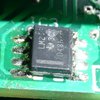Sir scooby . . . . .
Where you g o o o o o o o ?
Indeed . . . in using the first photo, it does reveal the in and out electrolytic decoupling filters and the center tab goes to that ground plane and one portion of the the regulator output goes to the end BROWN wire of the end connector.
The newest photos reveal what seems to be a ST Electronics 990xx series Brushed DC motor driver and what once appeared to be a 6 pin IC, is now a 8 pin unit and a commercial temp rated LM258/358 dual op amp.The E cap was hiding the full case profile .
I take it that the final photo is of the original IRF3205. Which is just their standard version and having laser etched markings.
BUT . . . the photo of the replacement, is letting me see but just the slightest trace of white in its center marking . . . therefore . . . it looks almost like it has been running hotter 'n hell.
How do / did the case appearances seem to you, at install time versus the present time condition ?
I see that original unit as bing a standard IRF3205 150 watt / 98amp unit.
Its also available as a Z version with a 170 watt / 110 amp unit.
If you step up to a IRF3305 its being a 330 watt / 140 amp unit.
TECH SPEC REFERENCING . . . .
https://alltransistors.com/mosfet/c...50&uds=55&id=98&qg=146&rds=0.008&caps=TO220AB
If this unit still has all parts installed and can run with wheels floating, why not do some metering at the power FET gate.
Have meter BLACK lead to battery ground and use the RED meter lead to the gate and test in DC voltage mode to see if there is any voltage change as the power is flipped on and the speed control is run thru its limits.
Then switch metering to AC voltage mode and do the same tests.
Pass on the observed voltage changes.
If nothing definitive . . . . . move back to the LM 258 and try the identical testing on its pins 1 and 7.
If you are lucky enought to have found a varying change on the FET GATE, you just might need a FET change out due to the present one having a blown GATE.
CASE REFERENCING . . . .

By your description, the POWER FET seems to have used a silicone membrane insulator pad between it and the heat sink, and they are usually pink, grey, red or white. But . . . . I additionally use a film of silicone grease on both sides.
With time and heat and compression, but no silicone grease, the transistor will stick to the membrane and usually tear if an attempt to remove the transistor is made.
https://www.digikey.ca/en/product-h...41-commercial-grade-electrical-insulator-pads
Thaaaaaaaaassssssit . . .
73's de Edd . . . . .
Show me a man with both feet firmly on the ground, and I’ll show you a man who can’t get his pants off.








